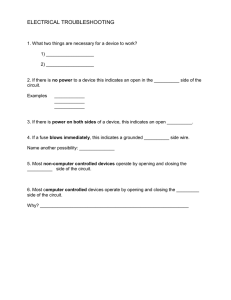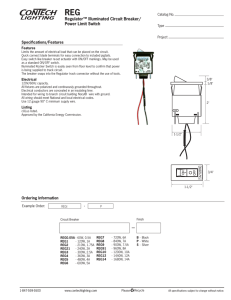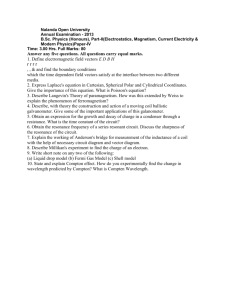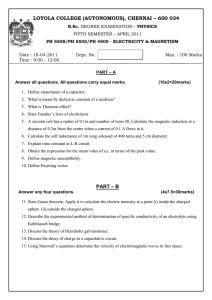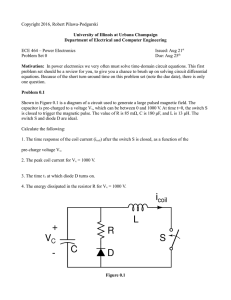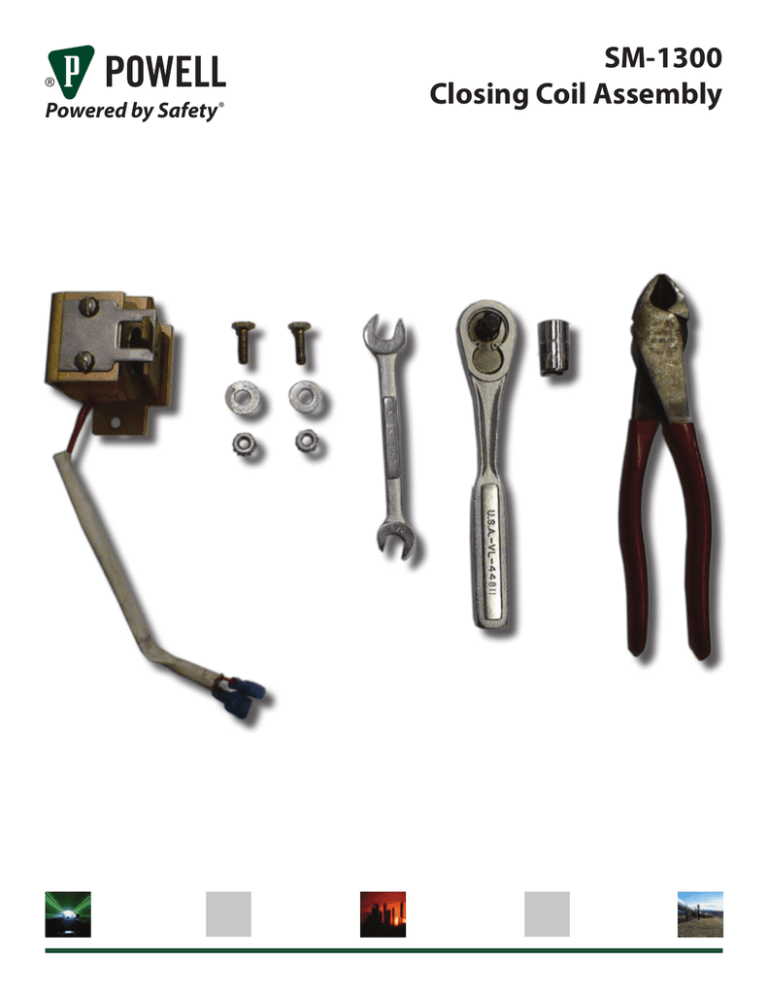
Powered by Safety ®
SM-1300
Closing Coil Assembly
Closing Coil Assembly
Contact Information
Powell Electrical Systems, Inc.
www.powellind.com
info@powellind.com
Service Division
PO Box 12818
Houston, Texas 77217-2818
Tel: 713.944.6900
Fax: 713.948.4569
Powered by Safety®
SM-1300
SM-1300
Signal Words
Qualified Person
As stated in ANSI Z535.4-2002, § 4.13-4.13.3 the
signal word is a word that calls attention to the
safety sign and designates a degree or level of
hazard seriousness. The signal words for product
safety signs are “Danger”, “Warning”, and
“Caution”. These words are defined as:
For the purposes of this manual, a qualified person,
as stated in NFPA 70®, is one familiar with the
construction and operation of the equipment and
the hazards involved.
!
DANGER
DANGER indicates an imminently hazardous
situation which, if not avoided, will result in
death or serious injury.
!
WARNING
WARNING indicates a potentially hazardous
situation which, if not avoided, could result in
death or serious injury.
!
In addition to the above qualifications, one must
also be:
1. trained and authorized to energize,
deenergize, clear, ground, and tag circuits
and equipment in accordance with
established safety practices.
2. trained in the proper care and use of
personal protective equipment (PPE)
such as rubber gloves, hard hat, safety
glasses or face shields, flash clothing, etc.,
in accordance with established safety
practices.
3. trained in rendering first aid if necessary.
CAUTION
CAUTION indicates a potentially hazardous
situation which, if not avoided, may result in
minor or moderate injury.
Not stated in ANSI Z535.4-2002, § 4.13-4.13.3
as a signal word but used in this manual is
“IMPORTANT”. This is defined as:
!
IMPORTANT
IMPORTANT indicates a section of the manual
covering a non hazardous situation, but
one where Powell feels proper attention is
warranted.
Powered by Safety®
SM-1300
Contents
Ch 1 General Information .................................................................................................1
A. Scope ................................................................................................................................................................2
B.Purpose .............................................................................................................................................................2
Ch 2 Safety ........................................................................................................................3
A.
B.
C.
D.
E.
F.
Safe Work Condition . ........................................................................................................................................3
Safety Guidelines ...............................................................................................................................................3
General .............................................................................................................................................................4
Specific ..............................................................................................................................................................4
X-Rays ..............................................................................................................................................................5
Safety Labels .....................................................................................................................................................5
Ch 3 Equipment Description .............................................................................................6
A. General .............................................................................................................................................................6
Ch 4 Installation ................................................................................................................7
A.Removing the Old Closing Coil Assembly and Installing the Replacement Closing Coil Assembly .............................7
1) Removing the Old Closing Coil Assembly . ......................................................................................................................... 7
2) Installing the New Closing Coil Assembly into the Circuit Breaker ............................................................................... 8
Powered by Safety®
i
Closing Coil Assembly
SM-1300
Figures
Figure 1
Figure 2
Figure 3
Figure 4
Figure 5
Figure 6
Figure 7
ii
Closing Coil Assembly .....................................................................................6
Repositioning the Escutcheon Plate ...............................................................7
Cutting the Tie Wrap .......................................................................................7
Removing Hex Head Bolts ...............................................................................7
Removing the Closing Coil ..............................................................................8
Securing the Closing Coil Assembly to the Circuit Breaker ............................8
Connecting the Closing Coil Wires to the Wiring Harness . ............................9
Powered by Safety®
SM-1300
Ch 1 General Information
!
WARNING
The equipment described in this document may contain high voltages and currents which can
cause serious injury or death.
The equipment is designed for use, installation, and maintenance by knowledgeable users of such
equipment having experience and training in the field of high voltage electricity. This document
and all other documentation shall be fully read, understood, and all warnings and cautions
shall be abided by. If there are any discrepancies or questions, the user shall contact Powell
immediately at 1.800.480.7273.
!
WARNING
Before any adjustment, servicing, part replacement, or any other act is performed requiring
physical contact with the electrical working components or wiring of this equipment, the power
supply must be disconnected. Failure to follow this warning may result in injury or death.
!
IMPORTANT
Powell reserves the right to discontinue and to change specifications at any time without incurring
any obligation to incorporate new features in products previously sold.
General Information
Powered by Safety®
1
Closing Coil Assembly
A. Scope
The information in this maintenance procedure
describes the following Closing Coil:
•
•
•
•
50026G01P
50026G03P
50026G04P
50026G02P
48VDC/120VAC
125VDC
250VDC
240VAC
All illustrations and photos are shown using
deenergized equipment.
!
WARNING
Be sure to follow the appropriate safety
precaution while handling any of the
equipment. Failure to do so may result in
serious injury or death.
This assembly can be used in the following
circuit breakers:
•
•
•
•
•
•
SM-1300
PowlVac® STD
PowlVac® CDR
PowlVac® ASD
PowlVac® Replacement Circuit Breakers
PowlVac® 38kV CDR
PowlVac-ND®
To the extent required, the products described
herein meet the applicable ANSI, IEEE, and
NEMA Standards; however, no such assurance
is given with respect to local codes and
ordinances which may vary greatly.
B.Purpose
The information in this maintenance procedure
is intended to provide information required to
properly install the closing coil described in
Ch 1 General Information, A. Scope.
This instruction bulletin provides:
1. Safety guidelines
2. Instructions for installation and placing the
closing coil into service
3. Procedure for critical adjustments
4. Illustrations, photographs, and description
of the closing coil
The illustrations contained in this document
may not represent the exact construction
details of each particular type of closing coil.
The illustrations in this document are provided
as general information to aid in showing
component locations only.
2
Powered by Safety®
General Information
SM-1300
Ch 2 Safety
A. Safe Work Condition
The information in Section A is quoted from
NFPA 70E 2004 - Article 120, 120.1 Establishing an
Electrically Safe Work Condition.
120.1 Process of Achieving an Electrically Safe
Work Condition
1. Determine all possible sources of electrical
supply to the specific equipment. Check
applicable up-to-date drawings, diagrams,
and identification tags.
2. After properly interrupting the load current,
OPEN the disconnecting device(s) for each
source.
3. Wherever possible, visually verify that all
blades of the disconnecting devices are
fully OPEN or that drawout type circuit
breakers are withdrawn to the fully
disconnected position.
4. Apply lockout/tagout devices in accordance
with a documented and established policy.
5. Use an adequately rated voltage detector
to test each phase conductor or circuit part
to verify they are deenergized. Test each
phase conductor or circuit part both
phase-to-phase, and phase-to-ground.
Before and after each test, determine
that the voltage detector is operating
satisfactorily.
Safety
6. Where the possibility of induced voltages
or stored electrical energy exists, ground
the phase conductors or circuit parts
before touching them. Where it could be
reasonably anticipated that the conductors
or circuit parts being deenergized
could contact other exposed energized
conductors or circuit parts, apply ground
connecting devices rated for the available
fault duty.
B. Safety Guidelines
Study this maintenance procedure and all other
associated documentation before installing the
closing coil assembly.
Each user has the responsibility to instruct
and supervise all personnel associated with
usage, installation, operation, and maintenance
of this equipment on all safety procedures.
Furthermore, each user has the responsibility of
establishing a safety program for each type of
equipment encountered.
It is mandatory that the following rules be
observed to ensure the safety of personnel
associated with usage, installation, operation,
and maintenance of these circuit breakers.
The safety rules in this instruction bulletin are
not intended to be a complete safety program.
The rules are intended to cover only some of the
important aspects of personnel safety related to
closing coil.
Powered by Safety®
3
Closing Coil Assembly
C. General
1. Only supervised and qualified personnel
trained in the usage, installation, operation,
and maintenance of the circuit breaker shall
be allowed to work on this equipment. It
is mandatory that this instruction bulletin,
any supplements, and service advisories be
studied, understood, and followed.
2. Maintenance programs must be consistent
with both customer experience and
manufacturer’s recommendations,
including service advisories and instruction
bulletin(s). A well planned and executed
routine maintenance program is essential
for circuit breaker’s reliability and safety.
3. Service conditions and circuit breaker
applications shall also be considered in the
development of safety programs. Variables
include ambient temperature; humidity;
actual continuous current; thermal cycling;
number of operations; interrupting duty;
and any adverse local conditions including
excessive dust, ash, corrosive atmosphere,
vermin and insect infestations.
D. Specific
1. DO NOT WORK ON AN ENERGIZED
CIRCUIT BREAKER. If work must be
performed on a circuit breaker, remove it
from service and remove it from the
metal-clad switchgear.
SM-1300
mechanisms. These mechanisms must be
serviced only by skilled and knowledgeable
personnel capable of releasing each spring
load in a controlled manner. Detailed
information regarding these mechanisms is
found in this instruction bulletin.
4. DO NOT ATTEMPT TO CLOSE THE CIRCUIT
BREAKER MANUALLY ON AN ENERGIZED
CIRCUIT.
5. DO NOT USE AN OPEN CIRCUIT BREAKER
AS THE SOLE MEANS OF ISOLATING A
HIGH VOLTAGE CIRCUIT. For complete
isolation, the circuit breaker shall be in
the disconnected position or shall be
withdrawn completely.
6. ALL COMPONENTS SHALL BE
DISCONNECTED BY MEANS OF A VISIBLE
BREAK AND SECURELY GROUNDED FOR
SAFETY OF PERSONNEL PERFORMING
MAINTENANCE OPERATIONS ON THE
CIRCUIT BREAKERS.
7. Interlocks are provided to ensure the
proper operating sequences of the circuit
breakers and for the safety of the user. If for
any reason an interlock does not function
as described, do not make any adjustments,
modification, or deform the parts. DO
NOT FORCE THE PARTS INTO POSITION.
CONTACT POWELL FOR INSTRUCTIONS.
2. DO NOT WORK ON A CIRCUIT BREAKER
WITH THE CONTROL CIRCUIT ENERGIZED.
3. EXTREME CARE MUST BE EXERCISED
TO KEEP ALL PERSONNEL, TOOLS, AND
OTHER OBJECTS CLEAR OF MECHANISMS
WHICH ARE TO BE OPERATED,
DISCHARGED, OR RELEASED. These
circuit breakers utilize stored energy
4
Powered by Safety®
Safety
SM-1300
E. X-Rays
F. Safety Labels
When high voltage is applied across the
contacts of a vacuum interrupter, there is the
possibility of generation of X-rays. The intensity
of the X-radiation is dependent on the peak
voltage and the contact gap. At the normal
operating voltage for this type of equipment,
the radiation levels are negligible. At the
voltages specified for testing, test personnel
shall be in front of the circuit breaker such that
the two layers of steel used in the frame and
front cover construction are between the test
personnel and the vacuum interrupters, and
that the test personnel be no closer than one
meter (3’) from the front of the circuit breaker.
THE CIRCUIT BREAKER SHALL BE EITHER
FULLY OPEN, OR FULLY CLOSED WHEN
MAKING HIGH POTENTIAL TESTS. DO NOT
TEST WITH CONTACTS PARTIALLY OPEN.
Safety
The equipment described in this document
has DANGER, WARNING, CAUTION, and
instruction labels attached to various locations.
All equipment DANGER, WARNING, CAUTION,
and instruction labels shall be observed when
the circuit breaker is handled, operated, or
maintained.
!
IMPORTANT
Warning and Caution labels are located in
various places in and on the switchgear and
on the circuit breaker removable element.
Always observe these warnings and caution
labels. Do NOT remove or deface any of these
warning/caution labels.
Powered by Safety®
5
Closing Coil Assembly
Ch 3 Equipment Description
Figure 1
SM-1300
Closing Coil Assembly
A. General
The closing coil assembly is located in the
center part of the mechanism area and is
bolted to the base pan.
!
CAUTION
Ensure that the control circuits are
deenergized and the circuit breaker is
deenergized, disconnected by means of a
visible break, and securely grounded. Do NOT
start to work on a closed circuit breaker or a
circuit breaker with the main closing spring
charged.
You should have the following when receiving
the closing coil assembly:
•
a
b
c
a. Closing Coil
b. Hardware
c. Tools Required for Installation
Closing Coil
Use existing hardware when replacing Closing
Coil:
• 1/4-20 x 3/4” HEX head bolt (2)
• 1/4-20 Flat Washers (2)
• 1/4-20 Lock Washers (2)
• 1/4-20 Star Nut (2)
Tools required:
• Flat head screwdriver
• 7/16 Socket Wrench
• 7/16 Socket
• 7/16 Open End Wrench
6
Powered by Safety®
Equipment Description
SM-1300
Ch 4 Installation
A.Removing the Old Closing Coil Assembly and
Installing the Replacement Closing Coil Assembly
1) Removing the Old Closing Coil Assembly
c. Elevate and secure the circuit breaker
so that there is at least 6 inches of clear
space below the base pan of the circuit
breaker.
Figure 3
Cutting the Tie Wrap
Perform the following steps to remove the
old closing coil assembly from the circuit
breaker:
!
CAUTION
Ensure that the control circuits are
deenergized and the circuit breaker is
deenergized, disconnected by means of a
visible break, and securely grounded. Do NOT
start to work on a closed circuit breaker or a
circuit breaker with the main closing spring
charged.
a. Remove the front cover of the circuit
breaker.
b. Reposition the escutcheon plate
by removing the bottom screw and
loosening the top screw and rotating
the plate as shown in Figure 2, tighten
top screw to hold plate in place.
Figure 2
Installation
d. Once the circuit breaker is stable and
secure, cut the tie wrap holding the two
wires from the closing coil assembly to
the wire harness (Figure 3).
e. Remove the two (2) 1/4-20 x 3/4” Hex
Head Bolts holding the closing coil from
below and the two (2) 1/4-20 Star Nuts
from above using a 7/16 socket wrench
and 7/16 open end wrench (Figure 4).
Figure 4
Removing Hex Head Bolts
Repositioning the Escutcheon Plate
Powered by Safety®
7
Closing Coil Assembly
f. Remove the closing coil from the
circuit breaker by lowering through the
opening of the circuit breaker base pan
(Figure 5).
Figure 5
Removing the Closing Coil
SM-1300
d. Once the circuit breaker is stable and
secure, insert the new closing coil
assembly up through the opening of
the base pan.
Note: Make sure the head of the hardware
is pointing towards the front of the
circuit breaker as shown in Figure 5.
Figure 6
Securing the Closing Coil Assembly to
the Circuit Breaker
2) Installing the New Closing Coil Assembly into
the Circuit Breaker
!
CAUTION
Ensure that the control circuits are
deenergized and the circuit breaker is
deenergized, disconnected by means of a
visible break, and securely grounded. Do NOT
start to work on a closed circuit breaker or a
circuit breaker with the main closing spring
charged.
Perform the following steps to install the
new closing coil assembly:
e. Prior to mounting the replacement
closing coil, apply Locktite 242 or equal
to the two (2) 1/4-20 x 3/4” Hex Head
Bolts. Secure the closing coil assembly
to the circuit breaker by inserting the
two (2) 1/4-20 x 3/4”Hex Head Bolts from
underneath the circuit breaker and
tighten in place using the two (2) 1/4-20
Star Nuts (Figure 6) and torque the two
(2) hex head bolts to 5-7 ft-lbs.
a. Remove the front cover of the circuit
breaker.
b. Reposition the escutcheon plate
by removing the bottom screw and
loosening the top screw and rotating
the plate as shown in Figure 2, tighten
top screw to hold plate in place.
c. Elevate and secure the circuit breaker
so that there is at least 6 inches of clear
space below the base pan of the circuit
breaker.
8
Powered by Safety®
Installation
SM-1300
f. Connect the wires from the wiring
harness to the closing coil assembly. No
adjustments required (Figure 7).
Figure 7
Connecting the Closing Coil Wires to
the Wiring Harness
g. Return the escutcheon plate to its
original position by loosening the top
screw and rotating plate to line up
bottom screw, replace bottom screw
and tighten both screws.
h. Carefully lower the circuit breaker to the
ground.
i. Close the circuit breaker several times
electrically to ensure the closing coil
assembly is functioning properly.
j. Reinstall the front cover of the circuit
breaker.
Installation
Powered by Safety®
9
Closing Coil Assembly
This page is intentionally left blank.
Powered by Safety®
SM-1300
SM-1300 Closing Coil
Assembly
October, 2008
Powell Electrical Systems, Inc.
Service Division - Houston
PO Box 12818 • Houston, TX • 77217
Powered by Safety®
©2006 Powell Industries, Inc. • All rights reserved.
Tel: 713.944.6900 • Fax: 713.948.4569
www.powellind.com
info@powellind.com

